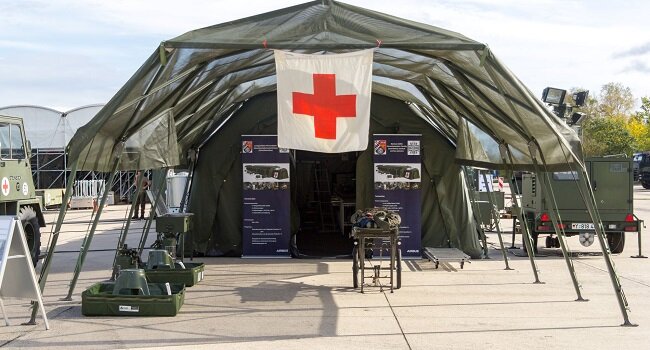With COVID-19 cases winding down to manageable numbers (though the virus is still a threat), some experts and parts of the general public can’t help but ask when the next pandemic will be. No one has a concrete answer, but the world clearly can’t take another crisis of such magnitude. Amid this uncertainty, healthcare issues like worker and supply shortages persist.
Nevertheless, one sector in the broader healthcare industry has distinguished itself for helping curb COVID’s spread—field hospitals. Even now, they remain crucial assets worldwide, from the earthquake-ravaged areas of Türkiye to the battlefields of Ukraine, saving millions of people from injuries or illness.
It’s safe to say that deployable field hospitals are in a prime position to transform the healthcare landscape. In fact, it may have already happened.
Filling A Crucial Gap
It’s essential to note that the pandemic aggravated global healthcare issues already present, such as lack of access. A 2017 joint study by the World Bank and World Health Organization (WHO) estimated that half the global population isn’t sufficiently covered. Despite reporting progress on this front, it isn’t across the board.
The report cited income disparity as a significant factor in this case. Around one-tenth of people worldwide spend 10% of their budgets out-of-pocket for healthcare, the threshold for healthcare spending under Sustainable Development Goals. Those forced to surpass this threshold are at serious risk of being more impoverished, affecting future access to adequate healthcare.
As soon as COVID went global and lockdowns prevented them from reporting for work, people found themselves in a bind. Even if they could afford hospital treatment, they had to contend with overburdened hospitals. At the height of the pandemic, intensive care units across the U.S. vastly exceeded their capacities, resulting in thousands of untreated cases.
Governments turned to field hospitals to ease the burden on healthcare facilities. Their responsibilities entailed managing patients with mild to moderate symptoms, freeing up more hospital beds for those with severe symptoms or serious non-COVID diseases.
But in most situations, field hospitals are the first point of contact for reporting new infections. They’re equipped with facilities such as a laboratory and a negative pressure isolation room to quarantine symptomatic cases properly.
Contrary to popular belief, field hospitals don’t need to serve in a similar capacity as their brick-and-mortar counterparts. One field hospital in Wuhan saw success in curbing infections by limiting eligible patients to specific criteria, such as having no history of psychiatric conditions or recent organ dysfunction. Its role was limited to COVID testing and basic treatment.
When Hospitals Are Insufficient
As well-equipped and well-staffed as fixed hospitals are, they’re susceptible to natural or manmade disasters for the simple reason that they’re buildings.
In Türkiye, the magnitude-7.8 earthquake last February left many buildings in ruins, including medical facilities. With these rendered unusable, rescue workers couldn’t prevent thousands of deaths in the first few days.
The international community’s response included field hospitals donated by the U.S., the U.K., Japan, France, Israel, and others, as well as non-governmental organizations. According to Türkiye’s health ministry, at least 32 local and foreign field hospitals have been set up since the disaster. Most of the severely injured were transferred to hospitals in Istanbul.

Field hospitals are a common sight in the aftermath of a calamity, which scientists believe is occurring more often than before. A review of the deadliest calamities by the World Meteorological Organization over the past several decades found that the top five emerged within the early 21st century. Three of them even happened within the same year.
Even with the world being proactive in mitigating climate change, disaster response remains the primary agenda for governments. Earthquakes, cyclones, and tsunamis can put a fixed hospital out of action, if not for the foreseeable future.
As a result, investments in field hospital solutions have been steadily rising. In 2021, the U.S. Army activated its 14th Combat Field Hospital in response to the uncertainties following the pandemic. Among its first initiatives was modernizing its equipment to tackle a broader range of health conditions, such as introducing computed tomography.
Field hospitals serve their purpose equally well in wartime. With Ukraine still in conflict, its healthcare system, while functional, is under untenable stress. Chronic shortages have made basic medical needs all but unaffordable to the average civilian, as per one WHO report.
Although field hospitals are among the waves of military aid Ukraine received, some focused on humanitarian efforts. Among the most notable was Israel’s Kohav Meir field hospital, deployed west of Lviv, far away from the fighting. It treated over 6,000 people and helped deliver one baby throughout its six weeks of operation.
A Key Aspect Of Future Crisis Care?
The extensive use of field hospitals in recent years has placed them in an opportune position to influence the healthcare landscape. Aside from governments and non-government organizations, medical centers have also begun investing in these solutions amid a wave of uncertainty moving forward.
While fixed hospitals won’t be phased out anytime soon, expect field hospitals to be employed more often in a growing number of situations.

















![Sirio Launches Global Research Institute for Longevity Studies [SIA]](https://www.worldpharmatoday.com/wp-content/uploads/2019/09/Sirio-218x150.jpg)

